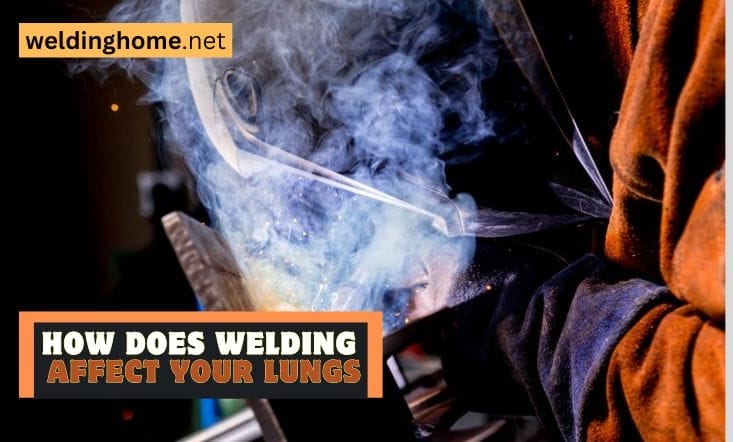How Does Welding Affect Your Lungs? An Overview 2024

How Does Welding Affect Your Lungs? An Overview 2023? The primary industrial welding technique joins materials to create products and buildings necessary for modern society. Beyond its importance, welding carries potentially hazardous hidden health concerns. One such concern is the impact of welding on lung health.
Inhaling the dangerous gases and fumes released during the procedure can harm one’s lungs. Dangerous substances such as metal oxides, ozone, and gases that might harm welders’ lungs are combined in these vapors. Prolonged exposure to these contaminants can result in more severe conditions like welding-related lung diseases and respiratory issues like pain and dyspnea.
This article highlights the potential risks while examining the intricate relationship between welding and lung health. In this post, I will examine How Welding Affects Your Lungs, the impact of welding on respiratory health, and strategies to reduce these dangers.
How Does Welding Affect Your Lungs Health
are linked to the inhalation of welding fumes, which contain a range of toxic gases and particles. Exposure levels can be extremely high depending on the type of material being welded and the conditions under which it is done. Welders are advised to use appropriate safety equipment, such as masks or respirators, and ensure adequate ventilation in their work areas.
Respiratory distress, from a ticklish throat to pulmonary irritation.
Welders also risk experiencing acute respiratory distress from inhaling fumes and particles in the air. This can range from a ticklish throat to pulmonary irritation and coughing. Prolonged exposure can cause dangerous long-term health implications, & Welding Affect Your Lungssuch as chronic bronchitis, asthma, or lung cancer.
Inhaling welding gas could also bring about other adverse health outcomes, Welding Affect Your Lungs including but not limited to headaches, dizziness, nausea, and exhaustion. Again, welders must use the necessary safety equipment and ventilation systems to reduce their exposure to welding gases.
Health Hazards Possed by Welding Fumes

The Composition of Welding Fumes
Metal Oxides
Welding generates metal oxides, microscopic particles generated when metals such as iron, nickel, chromium, and manganese react with oxygen in the air Welding Affect Your Lungs.
Gases
Welding fumes can contain toxic chemicals such as ozone, carbon dioxide, carbon monoxide, and nitrogen oxides, which can be breathed.
Volatile Organic Compounds (VOCs)
Some welding procedures emit VOCs, compounds that can evaporate into the air and have negative health consequences.
Flux Components:
Inhalation of Hazardous Particles
- Inhaling hazardous particles is dangerous to one’s health.
- Tiny particles can reach the lungs from smoke, dust, and odors.
- These particles can cause irritation of the eyes and skin, induce coughing, and cause persistent lung difficulties.
- Certain particles include poisons or metal fume fever, which makes them more dangerous.
- Wearing masks and employing sufficient ventilation decreases the danger of inhalation.
- Prolonged exposure might cause serious respiratory problems.
- Workers must be trained to recognize and reduce particle-related hazards.
- Prioritizing safety precautions protects both short- and long-term well-being.
Short-Term Respiratory Effects of Welding

- Welding Affect Your Lungs and can cause acute respiratory discomfort.
- Coughing and wheezing may result from inhaling welding fumes.
- Lung inflammation can cause shortness of breath.
- Exposure to fumes may irritate the eyes, nose, and throat.
- Welding gases can cause headaches and dizziness in the short term.
- Welders may become fatigued and endure brief respiratory difficulties.
- Welding-related symptoms usually emerge soon after being exposed.
- Adequate ventilation and protective equipment can help mitigate these effects.
- Individuals with pre-existing diseases may have their symptoms aggravated.
When heated, welding flux Welding Affect Your Lungs and includes chemicals that emit gases and particles, contributing to fume generation.
Welding Rod Coatings:
Welding rod coatings can include cadmium, lead, and hexavalent chromium, which emit poisonous gases when burnt.
Base Metal Contaminants:
Welding on coated or painted metals might result in the release of extra hazardous compounds from the coatings.
Particulate Matter:
Welding Affect Your Lungs Welding fumes contain varying-sized solid particles that can be absorbed into your lungs.
Hexavalent Chromium Compounds:
These are formed when stainless steel is welded and can represent a significant health concern, including respiratory difficulties and cancer.
Nickel Compounds:
Welding metals such as stainless steel and other nickel-containing materials can produce chemicals that might cause respiratory issues.
Magnesium Compounds:
Found in welding fumes, prolonged exposure might cause neurological problems & Welding Affect Your Lungs.
Welders must be aware of these substances and take appropriate measures.
Long-term Respiratory Effects of Welding
- Breathing fumes from welding for many years might cause significant welding Affect Your Lungs.
- Welders may develop persistent coughing and breathing difficulties.
- Long-term exposure can result in long-term lung damage.
- Asthma and bronchitis can deteriorate over time.
- Lung cancer risk, as well as that of other disorders, might increase.
- Long-term lung tissue scarring is a potential side effect.
- Welding particles can accumulate in the lungs, Welding Affect Your Lungs causing the health effects of the welder.
- Regular checkups are essential for monitoring lung health.
- Using protective equipment and enough ventilation can help prevent problems.
- Selecting a safe work environment reduces long-term dangers.
Protective Equipment
To prevent welding effects Welding Affect Your Lungs, the following protective equipment is required:
- Welding Helmet
- Respirator or Mask
- Welding Gloves
- Welding Jacket/Clothing
- Welding Apron
- Safety Glasses
- Earplugs or Earmuffs
- Welding Boots
- Welding Curtain/Screen
- Fire-Resistant Hat or Cap
Proper protective equipment ensures the safety and well-being of welders and those nearby.
Factors Influencing Lung Health
Welding Process Type
The number of gallons and kinds of gases produced by different welding methods vary. Arc welding, for example, emits more emissions than laser welding. Knowing the fume output related to each procedure helps welders select the best approach for a specific task.
Techniques for Ventilation and Safety
To reduce fume exposure, proper airflow in the welding area is vital. Local exhaust ventilation systems can effectively catch and remove welding gases, protecting welders’ respiratory health. Wearing adequate personal protective equipment (PPE) can also add an extra layer of protection.
Regulations and Guidelines
Occupational Safety and Health Administration (OSHA) Standards
OSHA offers policies and regulations that maintain the health and safety of employees, including welders. Employers must follow the exposure limits and safety procedures outlined in these guidelines.
Employers and employees should understand the regulations relevant to research on cancer. Welding Affect Your Lungs! In addition to preventing workplace accidents and illnesses, adherence to these standards helps organizations avoid expensive fines and legal obligations related to safety infractions.
Recommended Exposure Limits (RELs)
The purpose of RELs is to reduce the danger of harmful health consequences. Health authorities enforce concentration limitations. Following RELs helps prevent excessive exposure to hazardous substances.
It’s crucial to remember that RELs and exposure limits might differ by nation and regulatory body. To guarantee adherence and safeguard the health and safety of welders, employers should review their local occupational health and safety rules and recommendations. To reduce exposure to welding-related risks, thorough safety measures should be implemented, such as sufficient ventilation, PPE, and personnel training.
Minimizing Respiratory Risks
Robotics and automation
Automated welding systems have been developed as a result of technological advancements. These devices can reduce exposure to hazardous gases by reducing the need for human welding.
Improved Welding Techniques
Welding Affect Your Lungs but if you weld with safety Welding techniques that produce fewer fumes, such as pulsed gas metal arc welding, can improve welders’ respiratory health. Here are some lines on improved welding techniques:
Clean the Metal:
Before beginning to weld, clean the metal surfaces. Weak welds might be the result of dirty metal.
Right Welding Rod
Pick the appropriate welding wire or rod for the task. Different rods are needed for various materials.
Steady Hand
To create a solid and clean weld, use a steady hand during welding.
Correct Heat
Properly regulate the heat. Overheating can weaken the metal.
Good Angle
Hold the welding gun or flame at the proper angle to produce the best weld.
Practice:
Practice makes perfect, they say. To gradually increase your welding abilities, keep practising.
Conclusion
Although welding is an essential industrial procedure, its effects on Shortness of breath, Welding Affect Your Lungs, and the nervous system should not be disregarded. There is a chance that welders would breathe in dangerous fumes, which might cause immediate discomfort and an increased risk of lung problems.
The detrimental effects of welding on lung health can be reduced by using the appropriate safety measures, high concentrations such as PPE, ensuring adequate ventilation, and adhering to the rules.
FAQ’S
Is it normal to cough after welding?
Metal fume fever (MFF) has been defined as a “flu-like illness that develops after metal fume inhalation with symptoms appearing 3–10 hours after exposure. There can be a sweet metallic flavor at first. In the mouth, accompanied by a worsening dry cough and shortness of breath.
Can you get asthma from welding?
Fumes known as ‘welding fumes’ are produced during welding and ‘hot activity’ work and are associated with occupational asthma. When you are a welder, you have a greater chance of getting asthma than the average worker, particularly if you are welding stainless steel.
What are the harmful effects of welding?
Prolonged exposure to Welding Affect Your Lungs damage and various types of cancer, including lung, larynx, and urinary tract. Health effects from certain fumes may include metal fume fever, stomach ulcers, kidney damage, and nervous system damage.



